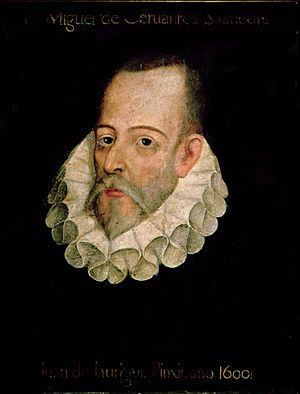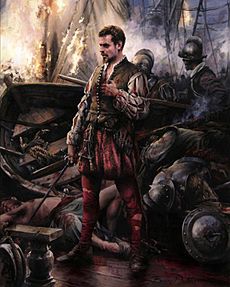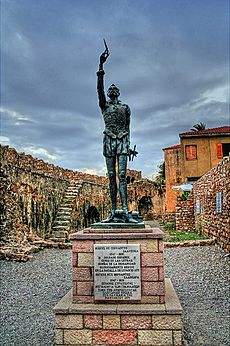Miguel de Cervantes facts for kids
Quick facts for kids
Miguel de Cervantes
|
|
|---|---|

This portrait, attributed to Juan de Jáuregui, is unauthenticated. No authenticated image of Cervantes exists.
|
|
| Born | September 29, 1547 (assumed) Alcalá de Henares, Crown of Castile |
| Died | April 22, 1616 (aged 68) Madrid, Crown of Castile |
| Resting place | Convent of the Barefoot Trinitarians, Madrid |
| Occupation | Soldier, tax collector, accountant, purchasing agent for Navy (Writing was a vocation which did not produce much income.) |
| Language | Spanish |
| Notable works | Don Quixote Entremeses Novelas ejemplares |
| Spouse | Catalina de Salazar y Palacios |
| Children | Isabel c. 1584 (illegitimate) |
|
|
|
| Signature |  |
Miguel de Cervantes Saavedra (September 29, 1547 (assumed) – April 22, 1616) is considered the greatest Spanish writer of all time. He wrote several novels, poems, and plays. Cervantes is best known for his novel Don Quixote, a story of a man who believes he is going on adventures.
Contents
Biography
1547 - 1566: Early Years
Miguel de Cervantes was born around September 29, 1547, in Alcalá de Henares, a city near Madrid, Spain. He was the second son of barber-surgeon Rodrigo de Cervantes and his wife, Leonor de Cortinas (c. 1520–1593).
Cervantes' father was regularly out of work, so Miguel spent much of his childhood moving and being supported by his mother Leonor. It is assumed Cervantes attended the Jesuit college in Seville.
1566 - 1580: Military service and captivity

Legal records show that the Cervantes family moved to Madrid in 1566. In 1569, Cervantes was forced to leave Spain and move to Rome where he worked in the household of a cardinal named Giulio Acquaviva.
In 1570, he enlisted in a Spanish Navy infantry regiment and was badly wounded at the Battle of Lepanto in October 1571. Cervantes received three separate wounds: two in the chest, and another that caused his left arm to be useless. Because of this, he was later called "El Manco de Lepanto" (English: The one-handed man of Lepanto, The one-armed man of Lepanto).
He served as a soldier until 1575 when he and his brother and Rodrigo left Naples on the galley Sol to return home. As they approached Barcelona on September 26, their ship was captured by Ottoman pirates, and the brothers were taken to Algiers to be sold as slaves. The Barbary pirates who captured them thought they would make more money if they held the brothers for ransom. Rodrigo had his ransom paid in 1577. After almost five years, and four escape attempts, Cervantes was set free in 1580 by the Trinitarians, a religious charity that specialized in ransoming Christian captives, and returned to Madrid.
1580 - 1616: Later life and death
Little is known of Cervantes between 1580 and 1587. In 1587, Cervantes was appointed as a government purchasing agent, then became a tax collector in 1592. He was briefly jailed several times for "irregularities," but quickly released. He applied several times for positions Spanish America but was rejected and had to remain in Spain.
From 1596 to 1600, he lived mostly in Seville, then returned to Madrid in 1606, where he remained for the rest of his life. Cervantes died on April 22, 1616, from diabetes. He was buried in the Convent of the Barefoot Trinitarians in central Madrid.
Literary career and legacy

Cervantes claimed to have written over 20 plays, such as El trato de Argel, based on his experiences in captivity. In 1585, he published La Galatea, a romantic story set in the countryside that was unsuccessful.
In 1605, Cervantes published the first part of his most famous novel, Don Quixote. He published a few more works between the two parts of Don Quixote, and published the second part in 1615. The Don Quixote series' purpose was to be different than the 'vain and empty' chivalric romances. The first was more of a comedy and was more popular than the second part, which was considered more complex and philosophical. Don Quixote is about an elderly man who loves the old stories of brave knights so much that he seeks out his own adventures. He gets lost in a fantasy world, but comes to his senses near the end of the story. One of the most famous scenes is his battle with a windmill (that he thought was a giant).
Don Quixote has been translated into all major languages, in 700 editions. Mexican author Carlos Fuentes suggested that Cervantes and William Shakespeare earned their place in the category of epic authors including Homer, Dante, Defoe, Dickens, Balzac, and Joyce.
In 1905, people celebrated the tricentennial of the publication of Don Quixote. Cervantina, a celebration of his plays by the Compañía Nacional de Teatro Clásico in Madrid, took place in 2016 on the 400th anniversary of his death. The Miguel de Cervantes Virtual Library, the largest digital archive of Spanish-language historical and literary works in the world, is named after the author. Man of La Mancha, the popular musical play of 1965, was based on Don Quixote.
Influence
Places
- Cervantes. A municipality in the province of Lugo, Galicia, Spain, but the name of the town is not based on Miguel de Cervantes (nor is there any evidence tying him or his family to this town).
- Cervantes. A municipality in the province of Ilocos Sur, Philippines.
- Cervantes. A township situated north of the Western Australian state capital Perth in Australia.
Television
- Cervantes is a recurring character in the Spanish television show El ministerio del tiempo, portrayed by actor Pere Ponce.
- Cervantes played a large role in the episode "Gentlemen of Spain" of the TV series Sir Francis Drake (1961–1962). He was portrayed by the actor Nigel Davenport and the plot had him heroically rescuing other Christian captives from the Barbary pirates.
Miguel de Cervantes quotes
- "Tell me what company you keep, and I'll tell you what you are."
- "Proverbs are short sayings drawn from long experience."
- "Time ripens all things. No man is born wise."
- "There is no greater folly in the world than for a man to despair."
- "He who loses wealth loses much; he who loses a friend loses more; but he that loses his courage loses all."
Interesting facts about Miguel de Cervantes
- His true appearance remains a mystery. All paintings of him are based on his description of himself at age 60.
- Miguel came from an upper class family, but they fell into financial trouble, and he grew up poor.
- In 1613, William Shakespeare wrote a piece called The History of Cardenio, based on a character from Don Quixote.
- He was excommunicated from the Catholic church three times because collecting taxes intended to pay for wars was considered to be a sin.
- Don Quixote did not make Cervantes wealthy at the time since authors did not receive payments when people bought their books.
- Even though he is thought to have written as many as 30 plays, only two survive today.
- The Spanish language is sometimes called la lengua de Cervantes (“the language of Cervantes“).
- World Book Day falls on April 23, the day Miguel de Cervantes was buried.
- His coffin was lost during renovation work in the 1670s, and his final resting place remained a mystery until 2015.
See also
 In Spanish: Miguel de Cervantes para niños
In Spanish: Miguel de Cervantes para niños
- Casa de Cervantes
- Instituto Cervantes
- Miguel de Cervantes Prize
- Miguel de Cervantes European University
- Miguel de Cervantes Health Care Centre
- Miguel de Cervantes Liceum
- Miguel de Cervantes Memorial
- Miguel de Cervantes University


